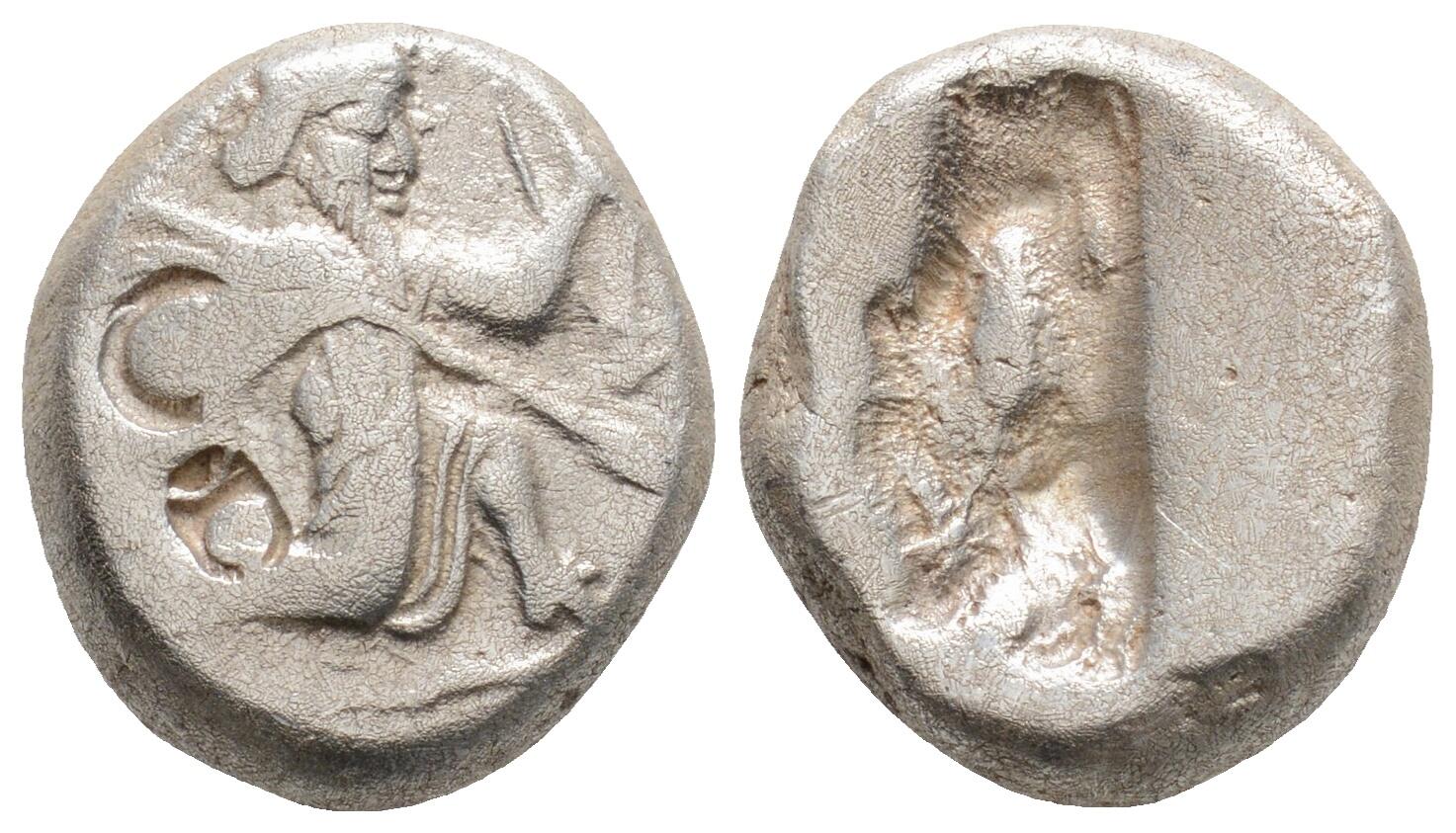S 1659 - Sardis (Persian), silver, sigloi (Group III: 485-420 BCE)
From SILVER
485 BCE - 420 BCE Silver 1,841 kg
Description
| ObverseInscription or printing placed on the obverse.: | Persian king in kneeling-running stance right, holding spear and bow, and with quiver over shoulder |
| ReverseInscription or printing placed on the reverse.: | Incuse rectangular punch |
Mint and issuing power
| MintIdentifies the place of manufacture or issue of a numismatic object.: | Sardis | Ancient regionAncient region.: | Lydia | Modern countryModern country: Turkey | AuthorityIdentifies the issuing power. The authority can be "pretended" when the name or the portrait of X is on the coin but he/she was not the issuing power. It can also be "uncertain" when there is no mention of X on the coin but he/she was the issuing power according to the historical sources: | Persian Empire |
Chronology
| FromIdentifies the initial date in a range assigned in a numismatic context. | 485 BCE | toIdentifies the final date in a range assigned in a numismatic context.. | 420 BCE | PeriodTime period of the numismatic object.: Classical 480-323 BC |
Physical description
| MetalThe physical material (usually metal) from which an object is made.: | Silver |
Median weightMedian of the weights of numismatic objects (in grams). in grams | 5.50 | DenominationTerm indicating the value of a numismatic object. Examples: tetradrachm, chalkous, denarius.: | siglos |
StandardStandard.: | Persian |
Image

S1659 Persia sigloi.jpg [1]
References
| Die study referencePublication of the study: | Carradice 19981Carradice 1998, p. 67-71 (Group III) | ||
| Coin series referenceReference to coin series study: | |||
Obverse dies distribution
| FrequencyFrequency of specimen in distribution. ᵖ | Number of obversesNumber of obverse dies. ᵖ (o) | % (o) | Number of coinsNumber of coins. (n) | % (n) | Die nameName(s) of the die(s). |
| 1 | 2 | 12.5 | 2 | 1.68 | C23, C41 |
| 2 | 2 | 12.5 | 4 | 3.36 | C18, C36, A |
| 3 | 1 | 6.25 | 3 | 2.52 | C20 |
| 5 | 2 | 12.5 | 10 | 8.4 | C19, C40 |
| 6 | 1 | 6.25 | 6 | 5.04 | C26 |
| 7 | 2 | 12.5 | 14 | 11.76 | C21, C22 |
| 9 | 2 | 12.5 | 18 | 15.13 | C37, C42 |
| 12 | 1 | 6.25 | 12 | 10.08 | C38 |
| 16 | 1 | 6.25 | 16 | 13.45 | C25 |
| 17 | 2 | 12.5 | 34 | 28.57 | C24, C39 |
| Total | 16 of 16 | 100 | 119 of 119 | 99.99 |
Reverse dies distribution
| FrequencyFrequency of specimen in distribution. ᵖ | Number of reverse diesNumber of reverse dies. (r) | % (r) | Number of coinsNumber of coins. (n) | % (n) | Die nameName(s) of the die(s). |
| 1 | 14 | 34.15 | 14 | 11.76 | 2, 3, 5, 13, 17, 18, 22, 23, 26, 33, 35, 36, 39, 40 |
| 2 | 8 | 19.51 | 16 | 13.45 | 11, 12, 14, 20, 29, 32, 34, 37 |
| 3 | 6 | 14.63 | 18 | 15.13 | 1, 4, 16, 21, 31, 38 |
| 4 | 5 | 12.2 | 20 | 16.81 | 8, 15, 27, 28, 41 |
| 5 | 4 | 9.76 | 20 | 16.81 | 6, 7, 10, 25 |
| 8 | 1 | 2.44 | 8 | 6.72 | 30 |
| 9 | 1 | 2.44 | 9 | 7.56 | 9 |
| 10 | 1 | 2.44 | 10 | 8.4 | 19 |
| 15 | 1 | 2.44 | 15 | 12.61 | 24 |
| Total | 41 of 41 | 100.01 | 130 of 119 | 109.25 |
Quantification
| Number of obversesNumber of obverse dies. ᵖ (o) | 16 | Number of singletons (o1)The number of singleton coins. ᵖ | 2 |
| Number of reverse diesNumber of reverse dies. (r) | 41 | Number of coinsNumber of coins. (n) | 119 |
| Coins per obverse dieNumber of coins per obverse die. (n/o) | 7.44 | Coins per reverse dieNumber of coins per reverse die. (n/r) | 2.9 |
| Reverse per obverse ratioRatio of obverse dies divided by reverse dies. (r/o) | 2.56 | Percentage of singletons (o1)number of coins (n) divided by the number of singletons (o1) ᵖ | 12.5 % |
| Original number of dies (O) (Carter 1983 formula)The estimation of the number of coins according to Carter 1983 ᵖ | 16.74 | Coins struck if 20,000 as average productivity per dieCoins made if the average productivity for obverses (according to Carter) is 20,000. ᵖ | 334,800 |
| Original number of dies (O) (Esty 2011 formula)The estimation of the number of coins according to the singleton formula in Esty 2011 ᵖ (O) | 18.49 | Survival rate if 20,000 as average productivity per dieSurvival rate if average productivity is 20,000. ᵖ | 0.00036 |
| Coverage (o = % of O) (Esty 1984 formula)Esty 1984 - coverage (% of O) ᵖ (o = % of O) | 98.32% | Die productivity if survival rate 1/2,000Average productivity if survival rate is 1/2,000. ᵖ | 14,217.44 |
| Weight of silver (in kg) if 20,000 coins per die (O = Carter formula)Carter 1983 * Median weight * 20000 (*10 if gold or electrum) ᵖ | 1,841 kg <br /> 1,841 kg | Die productivity if survival rate 1/5,000Average productivity if survival rate is 1/5,000. ᵖ | 35,543.61 |
Remarks